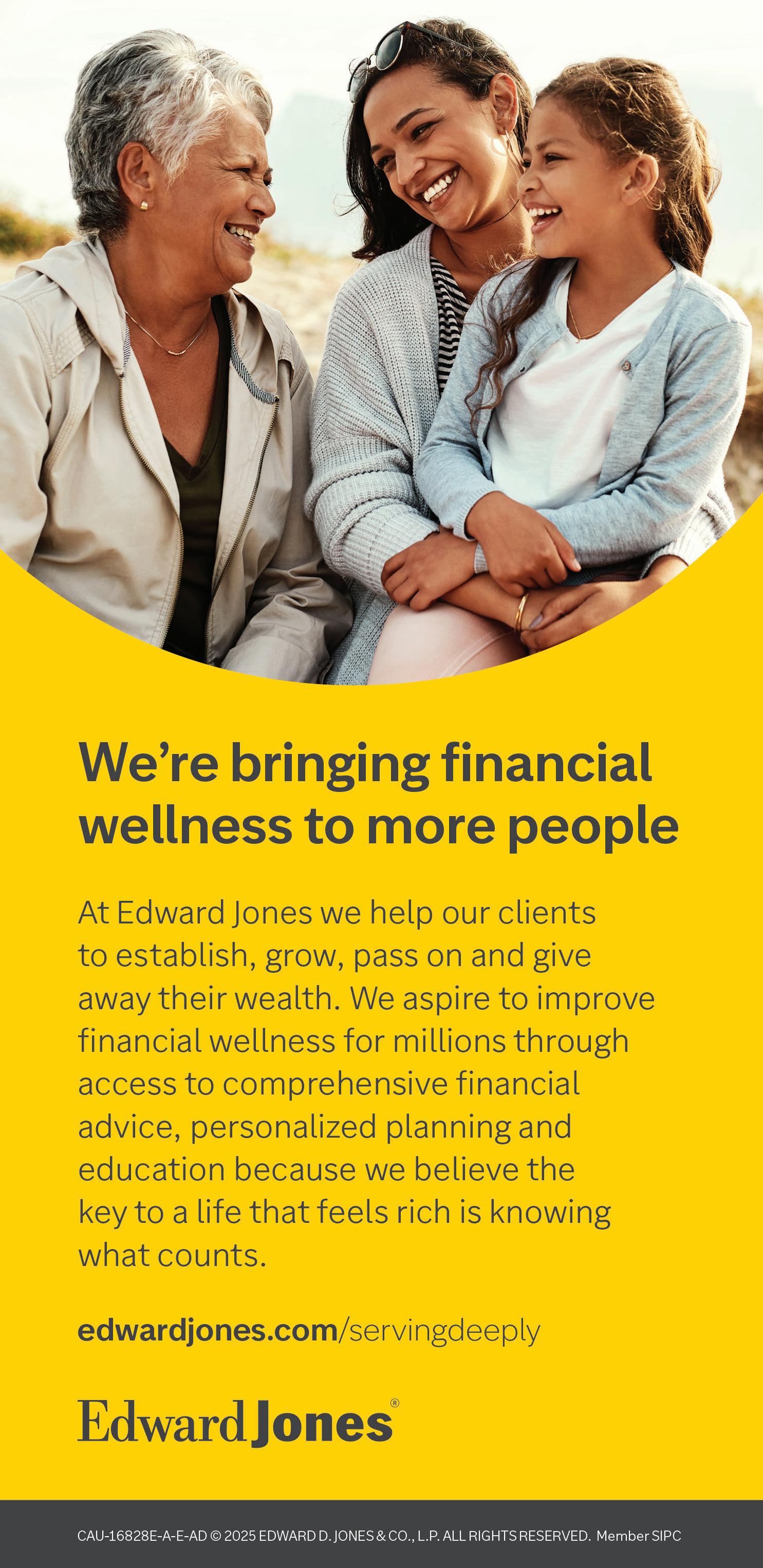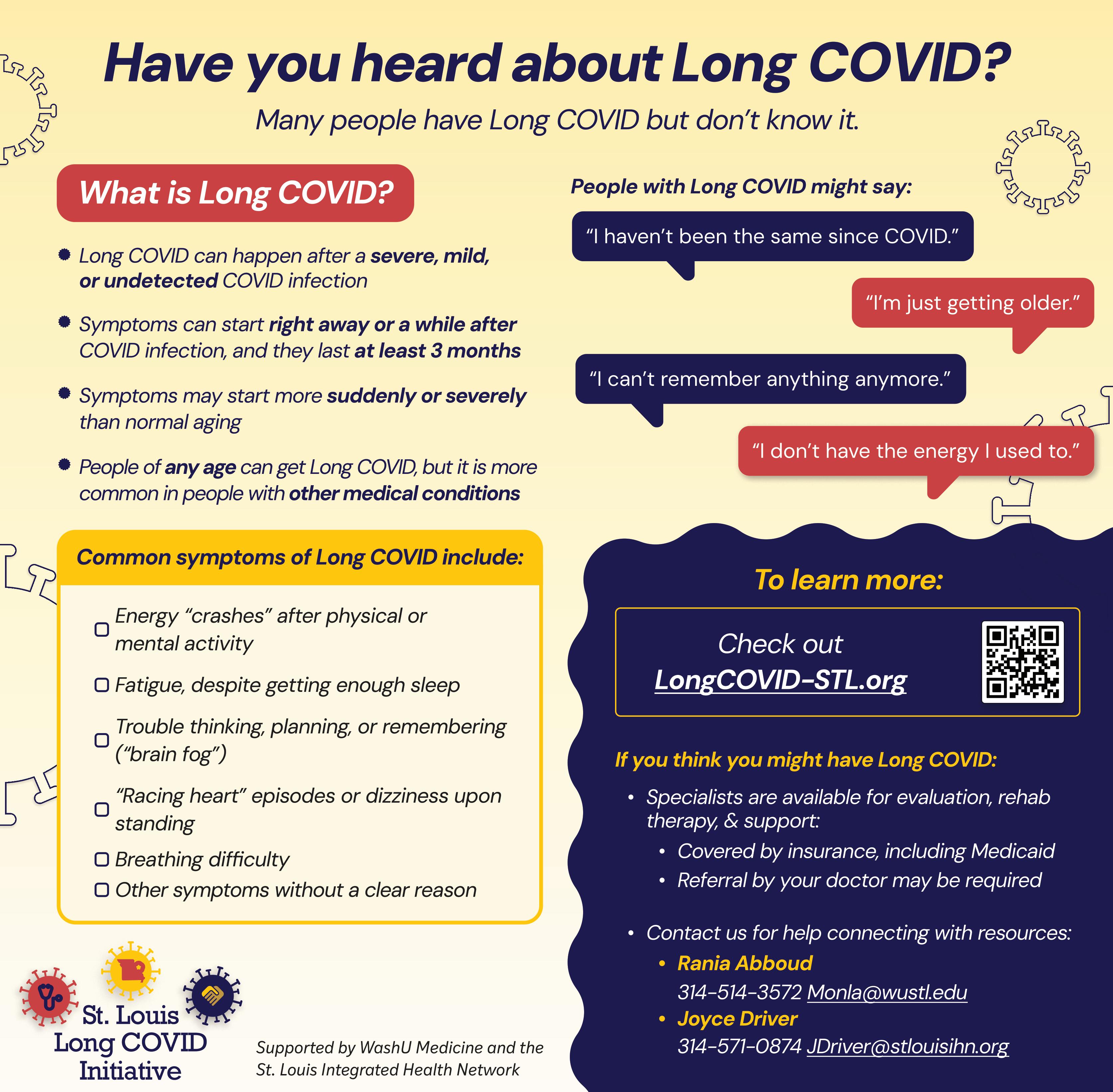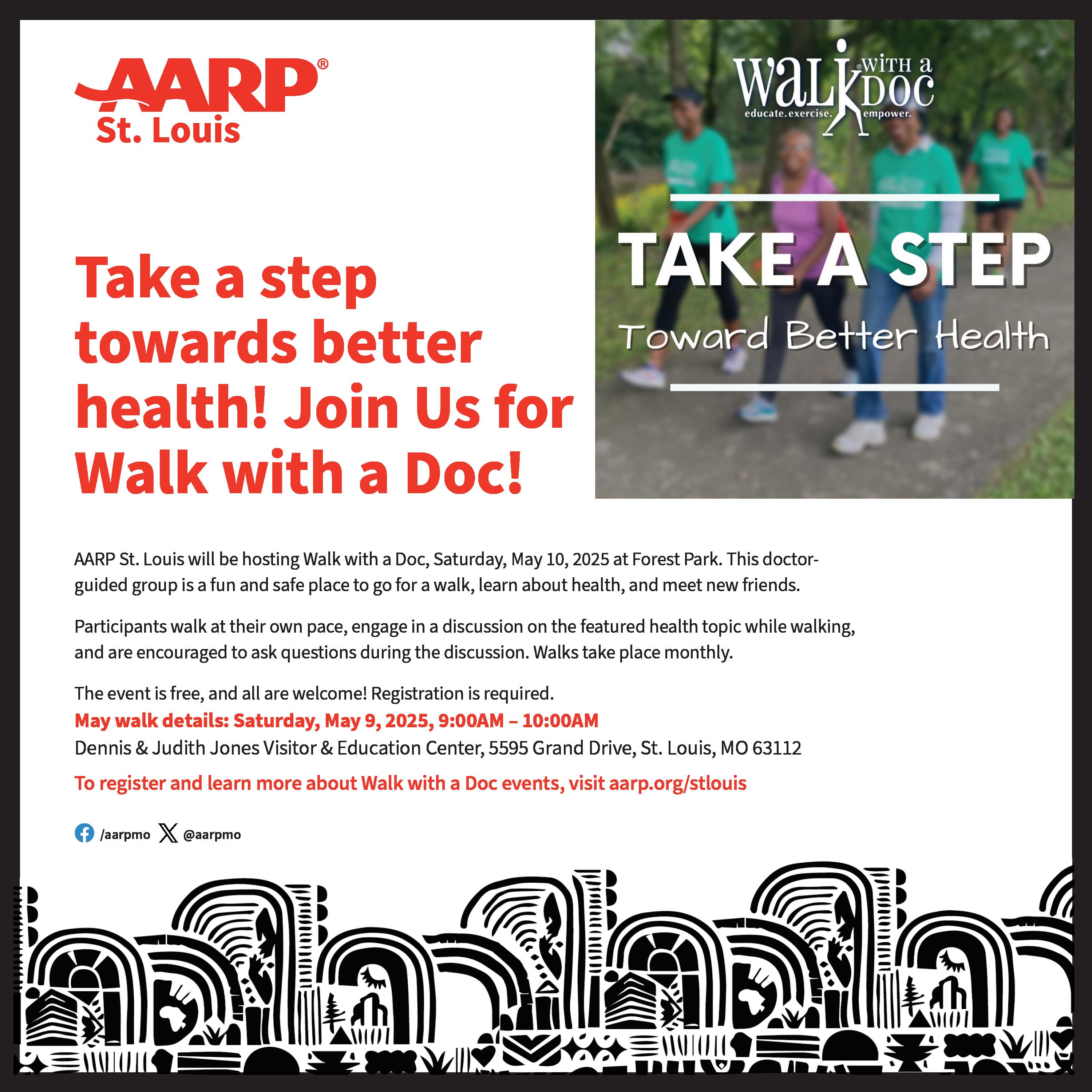




By Noam N. Levey Kaiser Health News
Underscoring the massive scale of America’s medical debt problem, a New York-based nonprofit has struck a deal to pay off old medical bills for an estimated 20 million people.
Undue Medical Debt, which buys patient debt, is retiring $30 billion worth of unpaid bills in a single transaction with Pendrick Capital Partners, a Virginiabased debt trading company. The average patient debt being retired is $1,100, according to the nonprofit, with some reaching hundreds of thousands of dollars.
A survey conducted on behalf of the Missouri Foundation for Health released in June 2024 showed that half of Missouri adults report having current medical debt or have had medical debt in the past five years (50%) including 39% who currently have medical debt.
The results align with data from a March 2022 national study of American adults conducted by KFF where 41% of US adults reported having current medical debt and another 16% reported having medical debt in the previous five years.
In the survey’s executive summary, MFH states “The root cause of medical debt, health care affordability, is a struggle for many Missouri residents. Overall, more than four in ten Missouri residents say they would not be able to pay an unexpected medical bill of $500 right away (42%).
Additionally, having health insurance does not alleviate the burden of these high costs. In fact, a large majority of Missourians with recent medical debt had health insurance when they received the medical care that resulted in their medical debt (78%).”
The Illinois Department of Healthcare and Family Services is partnering with Undue Medical Debt to administer the state’s Medical Debt Relief program, which has abolished more than $220 million dollars in medical debt for approximately 170,000 additional individuals statewide.
“By tackling medical debt at a statewide level, we can work with a wide range of healthcare providers—hospitals, health systems, and more—who see the

The Undue Medical Debt website reports that the nonprofit, with help of individuals’ donations, erased $1,035 in medical debt from her daughter’s birth and healthcare for the family. The nonprofit is partnering with the state of Illinois to help eliminate $220 million in medical debt.
value of this program in both supporting their community benefit initiatives and easing the financial burden on patients,” said Courtney Werpy Story, Undue Medical Debt vice president of government initiatives.
“Our hope is that this relief not only
helps families but also encourages people to re-engage with the healthcare system. We look forward to more medical debt relief for Illinois residents and drawing attention to this pressing crisis that is burdening an estimated 100 million families.”
The new deal will prevent the debt being sold and protect millions of people from being targeted by collectors. But even proponents of retiring patient debt acknowledge that these deals cannot solve a crisis that now touches around 100 million people in the U.S.
“We don’t think that the way we finance health care is sustainable,” Undue Medical Debt chief executive Allison Sesso said in an interview with KFF Health News. “Medical debt has unreasonable expectations,” she said. “The people who owe the debts can’t pay.”
Undue Medical Debt pioneered its debt relief strategy a decade ago, leveraging charitable donations to buy medical debt from debt trading companies at steeply discounted prices and then freeing patients from the obligation to pay.
The nonprofit now buys debts directly from hospitals, as well. And it is working with about two dozen state and local governments to leverage public money to relieve medical debt in communities from Los Angeles County to Cleveland to the state of Connecticut.
The approach has been controversial. And Undue Medical Debt’s record-setting purchase — financed by a mix of philanthropy and taxpayer dollars — is likely to stoke more debate over the value of paying collectors for medical debts.
Undue Medical Debt’s latest deal, which is spending $36 million to close, will help patients nationwide, according to the nonprofit. But about half the estimated 20 million people whose debts Pendrick owned live in just two states: Texas or Florida.
Neither has expanded Medicaid coverage through the 2010 Affordable Care Act, a key tool that researchers have found bolsters patients’ financial security by protecting them from big medical bills and debt.
KFF Health News is a national newsroom that produces in-depth journalism about health issues and is one of the core operating programs at KFF—an independent source of health policy research, polling, and journalism. This article first appeared on KFF Health News and is republished here under a Creative Commons license.
By David Von Nordheim and Amy McQueen
In the five years since COVID-19 was declared a public health emergency, about 7 in 10 Americans have tested positive for the virus at least once. For most people, a COVID infection is an unpleasant but short-term experience, with symptoms going away on their own within a few weeks. For some, however, COVID symptoms continue to linger months or even years after their initial infection, a condition known as Long COVID. This is not unique to COVID – other viruses can lead to long-term symptoms and chronic conditions. For example, the virus that causes chickenpox can also cause shingles years later.
Tanya Dotson of St. Louis first tested positive for COVID in April 2021 and has experienced persistent symptoms since. Her Long COVID symptoms were so debilitating that she had to resign from her job.
“Feeling tired, very tired, exhausted. I couldn’t put things together. Coughing, joints hurting. It was just bad… I worked for 30 years as a school bus driver. That’s gone. Who retires at the age of 52?”
Roughly 1 in 20 adults in the United States are currently living with Long COVID, defined as new or worsened symptoms starting after a COVID infection that last 3 months or longer. Common symptoms include trouble thinking or remembering (also known as brain fog), extreme fatigue and energy “crashes,” lightheadedness, and breathing difficulties. Because the symptoms of Long COVID vary for each patient, diagnosing it can be difficult.
“Healthcare professionals are getting good at identifying when a patient’s symptoms are possibly due to Long COVID, but we think there are still more people living with Long COVID than have been diagnosed with it,” says Dr. Gayathri Krishnan, medical director of the WashU Long COVID clinic. “We don’t have a specific blood test that tells us, ‘You definitely have Long COVID.’ It’s a bit of a detective game.” Another roadblock in diagnosing Long COVID is

that many people have never heard that COVID can cause lasting symptoms.
“Some people think, ‘I’m just getting older,’ or they say, ‘I don’t feel like myself anymore,’” describes Joyce Driver, who is a community referral coordinator with the St. Louis Integrated Health Network and helps connect people with medical and community resources.
There is no cure for Long COVID yet, but doctors say it is important for a person to know if they have Long COVID because specialized rehabilitation therapy, medications, and lifestyle
changes can greatly improve their quality of life. “We help patients think through their daily routines and find ways to make practical, feasible changes to improve their health and function,” says Dr. Abby Cheng, a physical medicine and rehabilitation doctor at the WashU Living Well Center. “This includes strategies like keeping a journal to identify symptom triggers, taking breaks between activities, adjusting sleep and eating routines, and more.” WashU and the Living Well Center offer counseling and rehabilitation for people with Long COVID who need
physical, occupational, or speech therapy. Life is not the same for Tanya as it was before Long COVID. She still has weekly therapy and is no longer a bus driver. But, she is able to find joy and purpose again – which has recently included taking care of four dogs that she adopted. “I have to plan my week and my energy. If I want to go somewhere on Friday, I can’t go to therapy or cook a meal on Wednesday or Thursday. But I can do the things that are most important to me. I want other people to know that Long COVID exists, and help is out there.”
Are you looking to purchase a home and feel overwhelmed by the mortgage process? Don’t let self-doubt hold you back. Stifel Bank & Trust is committed to building homeownership opportunities for the St. Louis community and to help ensure purchasing a home is less challenging. Located in Creve Coeur, our dedicated mortgage team has specialized in making owning a home more accessible in our hometown for nearly 20 years. With a 98% satisfaction rating from our clients, our steadfast dedication to our community is proven. Our lenders average 20 years in the industry and understand what it takes for successful
homeownership.
Our loan programs for St. Louis residents are designed to make the homebuying process affordable to individuals and families across the area, empower generations of potential homebuyers, and help build confidence along the way. Stifel Bank & Trust can help homebuyers discover which of our loan programs is the best fit. A few of our offerings and resources are described below:
Stifel Bank & Trust Affordable Mortgage Program (AMP)
Stifel Bank & Trust can make buying your home up to $7,500 more affordable
by providing qualified homebuyers a contribution towards closing costs and pre-paid items with no repayment required1.Learn more about how to AMP up your homebuying power at https:// bankwithstifel.com/mortgage/serving-st-louis/
Our affordable home purchase and refinance program for City Municipal Employees offers competitive interest rates for a variety of loan programs. This program is tailored for employees of the City of St. Louis, St. Louis Public Schools, St. Louis Public Library, and
Lambert International Airport. For more information, contact Stifel Bank at (314) 317-6920 or email WorkLiveSTL@ StifelBank.com.
As a Certified Lender for Missouri’s MHDC loan programs, Stifel Bank & Trust is reducing barriers to becoming a homeowner. The MHDC First Place Program offers affordable interest rates along with a Cash Assistance Payment (CAP) of up to 4% of the loan amount
See STIFEL, D7

At the turn of the new year, SSM Health introduced the Year of Hope to inspire team members, providers, and St. Louis area residents to spread good news throughout our health ministry and communities.
Hope unites us and can be the catalyst for powerful, positive change – both personal and communal.
To face our challenges with faith and optimism, the Year of Hope offers us moments to pause, reflect, and connect with our purpose while looking forward to the future with expectation.
SSM Health’s rich legacy is rooted in a commitment to ensuring all people –especially those most in need – receive high-quality, compassionate care. It is in this spirit that we continue to address the underlying causes of health disparities through a comprehensive, integrated approach to community health.
This includes incorporating screening for social determinants of health into routine patient care encounters. Our electronic referral management platform is embedded in Epic patient records, so we can connect our patients, their providers, and community-based support organizations to meet such needs as food insecurity, access to safe housing, transportation, and more.
When we work with others to improve those conditions, we bring hope and compassion – and God’s healing presence –ensuring that all people have the appropriate resources and connections to live a healthier life.
Let’s take a few moments to pause in prayer, self-reflect, and take action. Our journey of hope continues:
I have hope for health equity for all.
Reflection:
“The essence of global health equity is the idea that something so precious as health might be viewed as a right.”
—Paul Farmer, MD, PhD, American medical anthropologist and physician
A prayer:
Lord,

You call us to be aware of the chasm in health care today, the disparity in care that results in worse outcomes for persons who are made vulnerable because they are unjustly kept outside the mainstream of community life. You call us to act for justice. You call us to bring comfort and healing to those who do not sit at the table today. You call us to advocate for persons on the margins of society, and to promote and defend human dignity.
Committed to the beliefs that every person is a treasure, every life a sacred gift, bless our work to diminish the chasm of disparity and bring about greater justice and equity in health care. Bless our work and all those in our community who need our care. We ask this in the name of Jesus and in the power of the Holy Spirit.
Amen
• How can you increase your knowledge about health inequities that your local community faces?
SSM Health’s Year of Hope is an inspiration to the region, and has included hope for health equity, social justice, and the planet.
• Discover ways you can make a difference in your community – whether it’s donating clothing or volunteering to serve meals – take action.
• Engage your family and friends and learn about ways to impact the health of your community, together.
At SSM Health, we follow the path inspired by our founding sisters. When they landed in St. Louis in 1872, the sisters had just five dollars between them. Yet, the sisters tended to the sick regardless of whether they could pay for that care. Today that work continues as we care for the needs of our communities, and work toward health equity for all -- fundamental to fulfilling our Mission and Vision. We know that 80 percent of factors that impact people’s health are beyond the walls of our health care facilities – factors including socioeconomic
status, education, employment, and physical environment. When we work with others to improve those conditions, we instill hope and empower all our families, friends, and neighbors to live their healthiest lives.
Take a few moments to pause in prayer, self-reflect, and take action. Our journey of hope continues:
I have hope for social justice.
Reflection:
Lord,
Grant us a vision of your world as your love would have it:
a world where the weak are protected, and none go hungry or poor; a world where the riches of creation are shared, and everyone can enjoy them; a world where different races and cultures live in harmony and mutual respect; a world where peace is built with justice, and justice is guided by love.
Give us the inspiration and courage to build it, through Jesus Christ our Lord.

Continued from D4
to first-time homebuyers2 and veterans. The MHDC Next Step Program is geared towards non-first-time homebuyers with downpayment and closing cost assistance.
Stifel Bank & Trust supports financial education throughout the St. Louis community through online courses and partnerships with local institutions. With resources for every age, we strive to foster development and growth for individuals across life’s stages.
Stifel Bank & Trust offers free financial education on topics such as budgeting, home buying, and more. Building your understanding of financial capabilities may be the most valuable form of investing in yourself. Get started at https://stifelbank.banzai.org/wellness.
In Partnership with the United Way of Greater St. Louis and LionForge Labs, Stifel Bank & Trust offers free resources that help teach children the importance of healthy money management. Our coloring and comic books combine adventure and learning to spark curiosity among the younger generations of our community. View our free Budget Bunny materials at https://www.budgetbunny.com/
Meet Bud the Budget Bunny on April 12th at the St. Louis Zoo! For more information, visit https://www.moneysmartstlouis.org/ event/money-smarts-month-kids-zoo-safari/
Want to learn more about our financial education offerings?
Continued from D5
Amen -Author Unknown
Self-reflective questions
• What gives you hope for social justice?
• When do you feel the greatest sense of
Contact Stefanie Mitchell, Community Lending Development Specialist, at (314) 317-1235 or via email mitchellst@stifelbank.com, NMLS# 2086497
Ready to purchase a home?
Contact Daulton Hillemann, Vice President/Mortgage Loan Officer, at (314) 317-6926 or via email hillemannd@stifelbank.com, NMLS# 1296887.
Start your journey to homeownership today by visiting www.StifelMortgage.com
Let Stifel Bank & Trust help you unlock the door to your dream home. Stifel Bank & Trust, NLMS #375103.
Maximum lender contribution of $7,500 is subject to limitations of selected loan type – FHA, Conventional, or VA. Additional eligibility requirements apply. FHA – closing cost contribution limited to the lesser of actual costs incurred or 6% of the sale price. Conventional – closing cost contribution limited to the lesser of the actual costs incurred or 3% (< 10% down), 6% (10 – 24.99%), or 9% (25% or more) of sale price. VA – closing cost contribution limited to the lesser of actual costs incurred or 4% of the sale price. Borrower may be required to participate in homeownership education program.
First-time homebuyers are defined as those persons who have not owned a home or had an ownership interest in a primary residence for the past three years. The amounts indicated for MHDC price and income limits are based on 1-2 occupants 18+. Limits may increase if additional occupants are 18+.
Please contact your Stifel Bank & Trust Lender for loan program details. This information is provided for informational purposes only and is not intended to extend consumer credit as defined by section 1026.2 of Regulation “Z.” Interest rate, program terms, and conditions are subject to change without notice.
Geographic restrictions may apply.
belonging at work? What can you do to help others feel this sense of belonging?
• Seek out someone who is different than you and learn about your differences and how you are alike – faith, ethnicity, and more.
These articles were originally published on the ssmhealth.com website respectively in February and March.

Whether you’re a resident buying your first home or newly out of residency purchasing your dream home, you may qualify for special financing. Even without a current job, you can still qualify if you’re set to start within 60 days of closing, with a signed employment contract.
A doctor mortgage loan is a type of mortgage that is designed specifically for doctors and other medical professionals.
Medical schools and schools of osteopathic medicine are large financial investments. Physician loans have features and benefits designed for borrowers who are making that commitment.
For example, unlike a conventional mortgage, they require low or no down payment. Both resident and attending physicians can qualify for this loan, which can be an excellent and affordable way to buy a home.
If you’re a physician looking to buy, call check to see if you qualify for our doctor loan program.
Additional considerations for a Physician Home Loan:
1. Is it a good time for you to buy a home?
It’s important to note that while a doctor home loan can make it easier for medical professionals to qualify for a mortgage and manage their student debt, they are still a financial obligation, and it’s important to carefully consider whether taking on a mortgage is the right decision for your financial situation. It’s a good idea to collaborate with a financial advisor or mortgage professional to evaluate your options and determine the best course of action.
2. Can you afford the monthly payment?
Another important thing to remember about a physician mortgage loan is that it’s only for your primary residence. Also, these types of loans have a number of benefits, but they can also have a downside. For instance, mortgage rates can be

While they are often referred to as “doctor mortgage loans,” this type of mortgage is designed for doctors as well as other medical professionals. Midwest BankCentre offers a physician loan program for M.D.s and D.O.s in the St. Louis area, providing preferred pricing on local home loans.
higher than conventional loans, possibly making your monthly payment higher.
3. Have you shopped around?
In order to get the most out of your doctor mortgage loan, you should compare multiple offers and determine which ones are the most favorable. It is also
helpful to get pre-approved. This will let you know if any problems arise during the doctor home loan process. It is always a good idea to work with an expert mortgage banker like Midwest BankCentre to find the best options for your situation. By doing this, you will be better prepared
to avoid common mistakes.
To qualify for a doctor home loan, you typically need to be a licensed medical professional or a graduating resident with a job offer. Requirements usually include a good credit score, proof of future income, and sometimes a down payment, though some programs offer lower down payments.
How are interest rates determined?
Interest rates for doctor loans are determined based on factors such as current market conditions, the borrower’s credit score, loan amount, and down payment. Lenders may also consider the borrower’s professional status and income stability when setting rates.
Can medical students obtain a doctor home loan?
Yes, medical students can often obtain a doctor home loan, but they typically need to provide proof of their future income, such as a residency or job offer letter, and meet other requirements like a good credit score. The terms and availability can vary by lender.
Can doctor loans be used for refinancing?
Yes, doctor home loans can be used for refinancing. They allow medical professionals to replace an existing mortgage with a new one, often offering favorable terms like no private mortgage insurance (PMI) and potentially better rates. Midwest BankCentre offers online loan applications. Once an application has been received, a local mortgage specialist will contact the applicant. Mortgage specialists live and work in the Midwest, which means that they are knowledgeable of the local housing market and are prepared to offer advice based on unique needs. Visit midwestbankcentre.com for additional information.
By Orvin T. Kimbrough, Chairman and CEO at Midwest BankCentre
Let’s be honest—most people don’t wake up thinking about interest rates, bond yields, or the Federal Reserve. But those numbers? They quietly shape our financial lives.
They determine whether your mortgage remains affordable. Whether your business can grow—or needs to pause. Whether your credit card debt becomes manageable or overwhelming. Whether your retirement savings are working for you or against you.
This isn’t just Wall Street talk. It’s everyday reality for anyone who wants to build wealth, security, and opportunity. And it all comes down to understanding one thing: how interest rates move—and what that movement means for you.
In banking, I think every day about three types of risk. These same risks affect your household and business too:
• Credit Risk – Are you borrowing at a fair rate? Or paying more than you should?
• Liquidity Risk – Do you have cash available when life throws a curveball?
• Interest Rate Risk – How do rate changes affect your loans, savings, or investment decisions?
When you understand these risks, you stop reacting to the system—and start using it to your advantage.
value.
This concept may seem abstract, but it plays out in your everyday finances.
If you locked in a 4% mortgage last year and today’s rates jump to 6%, you’re in a great spot. But if rates drop to 3%, you might consider refinancing. The same logic applies to credit card balances, business loans, and investment choices.

Orvin T. Kimbrough
The Seesaw Effect of Interest Rates
Interest rates work like a seesaw. When new bonds offer higher rates, older bonds become less valuable. When new bonds offer lower rates, older ones gain
What You Can Do—Today
Here’s what smart financial positioning looks like in both rising and falling rate environments:
If interest rates are rising…
• Lock in lower rates before borrowing becomes more expensive.
• Pay down high-interest debt—especially variable-rate loans.
• Keep extra cash on hand; higher rates can put pressure on your monthly budget.
If interest rates are falling…
• Explore refinancing options on your mortgage, car loan, or business debt.
• Consider investments that perform better in low-rate environments.
• Take advantage of cheaper borrowing to make strategic moves.
Stay Ahead of the Seesaw
If bond yields go up, loan rates typically rise—challenging for borrowers but rewarding for savers. If yields fall, borrowing becomes cheaper—but savings returns may decline.
Your financial future depends on more than hard work—it depends on understanding the levers that shape the system. Interest rates are one of the biggest.
So here’s your next step: Check the rates on your mortgage, credit cards, and savings. Ask yourself: Am I making the most of today’s environment? Because in finance, the people who understand the seesaw don’t get caught off guard. They stay ready—and rise with it.

By Laura Mehegan and Chuck Rainville AARP Research
Workers feel their employers have a responsibility to help them maintain their health, and those with access to employer-based health and wellness benefits are more satisfied with their jobs, according to an AARP Research survey.
Benefits were found to be bidirectional. On the organization side, employer-based health and wellness benefits are connected to a higher level of job satisfaction; on the worker side, they’re connected to better brain health, overall health, and mental health outcomes.
The 15-minute online survey of workers ages 18 and older, which explored workplace policies that support brain health, suggests that business owners and other employers that don’t offer health and wellness benefits should consider doing so. Organizations in the retail sector in particular need to do more to support their workers’ health and wellness.
Less than half of American workers report receiving specific health and wellness benefits. These benefits include, among others, health screening, biometric assessments, vaccinations, ergonomic workstation access, fitness programs, and mindfulness, meditation, yoga, and relaxation training. The survey focused on a dozen health and wellness benefits with some tapping into specific needs such as addressing alcohol abuse and others more broadly focused — for example, promoting a culture of health.
Despite the two-way payoff of employers offering health and wellness benefits, few of those with access to benefits are using them. The most common health and wellness benefit available to 42% of workers is “health screening, biometric assessment, and vaccinations.” It was also the most accessed, yet just 28% reported using it. The least commonly offered benefit is “mindfulness, meditation, yoga, and relaxation training,” available to 20% of workers but only used by 7%.

While the relationship between aspects of employment (e.g., benefits, pay, satisfaction, tenure) and outcomes is complex, job satisfaction factors into worker outcomes. Workers with access to health and wellness benefits have higher levels of job satisfaction, the survey found. And higher job satisfaction is related to better health-related outcomes.
Further, most workers expect employers to offer them support. More than half of employees think their employers have the responsibility to help them maintain their mental health (61%), financial security (57%), and brain health/mental sharpness (55%), at least to some extent. Just under half (48%) think employers should help them maintain their physical health as well.
American workers who feel their brain health is supported by employer leadership rate their brain health higher than those who feel less supported. Among a subset of workers who feel employers
An AARP study shows that employers that offer benefits including fitness programs, meditation, yoga, and relaxation can expect a positive return on the investment. Employerbased health and wellness benefits are connected to a higher level of job satisfaction.
should provide opportunities to engage in activities that benefit their health and wellness, fewer than half (47%) feel their leadership supports their brain health and mental sharpness. Differences in self-reported brain health are significant by level of support from leadership.
With or without worker access to health and wellness benefits, a key to a healthful work environment is the work itself. Those who report little to no job stress are more likely to rate their health and brain health as excellent or very good, compared to workers overall and those with a moderate to high level of stress. Conversely those with a high level of job stress have lower average mental well-being scores and higher levels of depression and anxiety.
American retail workers need more support, according to the results of the survey, which included food service, theaters, and sports venues as part of the
retail sector.
Workers in this category were less likely to be satisfied with aspects of their job and had less access to employer-based health and wellness benefits. Just 45% of retail workers report having at least one health and wellness benefit, compared to 71% overall.
Workers in these businesses were also less likely to rate their brain health and overall health as excellent or very good. Retail workers are the least likely to have any health and wellness benefits and significantly fewer rate their brain health (46%) and overall health (40%) as excellent or very good. That represents the lowest self-reported brain health and overall health of all the job categories. Overall, 62% and 51% of workers report having excellent or very good brain health and overall health, respectively.
This article was originally published by AARP on Sept. 6, 2024 and updated on November 1, 2024.

